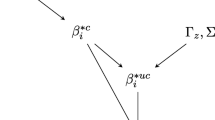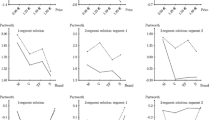Abstract
In this paper, we study the impact of customer stochasticity on firm price discrimination strategies. We develop a new model termed the Bayesian Mixture Scale Heterogeneity (BMSH) model that incorporates both parameter heterogeneity and customer stochasticity using a mixture model approach, and demonstrate model identification using extensive simulations. We estimate the model on yogurt scanner data and find that compared to the benchmark mixed logit and multinomial probit models, our model shows that markets are less price elastic, and that a majority of customers exhibit stochasticity in purchases; our model also obtains better prediction and more profitable targeting strategies.
Similar content being viewed by others
Notes
The Web Appendix material is available from the authors on request.
While for simplicity, we maintain the same true value of the price coefficient for the MIXL and HetSMNL utility components of the BMSH model; we have conducted additional simulations to ensure that the true values are recovered when these coefficients are different (\( {\beta}_p^M\ne {\beta}_p^S \)). Results are available from the authors on request.
We term this as heterogeneous SMNL (HetSMNL) to distinguish it from the SMNL model of Fiebig et al. (2010) (Figure 1, page 398) which does not have heterogeneity in the ASCs.
However, in the case of 70 % MIXL, NP = 100, T=10, price coefficient = −6, the MNP model does not converge well and shows multimodality in the posterior distribution.
However, we note that the DIC measure may not always give accurate values for mixture models. We thank an anonymous reviewer for pointing this out (see Geweke and Keane 2006).
These figures for the other three brands as focal brands are available from the authors on request.
We have examined conditions under which targeted coupon face values are higher for two different discrete choice models and find that this is related to the differing price coefficients as well as the magnitude of difference between the odds computed using the two different models. The factors affecting different optimal coupon face values are thus more nuanced than just a comparison of price coefficients or price elasticities in the two models would suggest. Further results are available from the authors on request.
References
Ben-Akiva, M., & Lerman, S. (1985). Discrete choice analysis: theory and application to travel demand. Cambridge: MIT Press.
Chintagunta, P. K. (1992). Heterogeneity in nested logit models: an estimation approach and empirical results. International Journal of Research in Marketing, 9(2), 161–175.
Feit EM (2009) Extending the generalized multinomial logit model: error scale and decision-maker characteristics. http://papers.ssrn.com/sol3/papers.cfm?abstract_id=1566068. Accessed August 23, 2012.
Fiebig, D. G., Keane, M. P., Louviere, J., & Wasi, N. (2010). The generalized multinomial logit model: accounting for scale and coefficient heterogeneity. Marketing Science, 29(3), 393–421.
Geweke, J., & Keane, M. (2006). Smoothly mixing regressions. Journal of Econometrics, 138(1), 252–290.
Hartmann, W. R. (2010). Demand estimation with social interactions and the implications for targeted marketing. Marketing Science, 29(4), 585–601.
Hutchinson, J. W., Zauberman, G., & Meyer, R. (2010). Commentary—on the interpretation of temporal inflation parameters in stochastic models of judgment and choice. Marketing Science, 29(1), 23–31.
Jain, D. C., Vilcassim, N. J., & Chintagunta, P. K. (1994). A random-coefficients logit brand-choice model applied to panel data. Journal of Business & Economic Statistics, 12(3), 317–328.
Kasahara, H., & Shimotsu, K. (2009). Nonparametric identification of finite mixture models of dynamic discrete choices. Econometrica, 77(1), 135–175.
Maddala, G. (1983). Limited-dependent and qualitative variables in econometrics. Cambridge: Cambridge University Press.
Pancras, J., & Sudhir, K. (2007). Optimal marketing strategies for a customer data intermediary. Journal of Marketing Research, 44(4), 560–578.
Quandt, R. E. (1972). A new approach to estimating switching regressions. Journal of the American Statistical Association, 67(338), 306–310.
Rossi, P. E., McCulloch, R. E., & Allenby, G. M. (1996). The value of purchase history data in target marketing. Marketing Science, 15(4), 321–340.
Salisbury, L. C., & Feinberg, F. M. (2010a). Alleviating the constant stochastic variance assumption in decision research: theory, measurement, and experimental test. Marketing Science, 29(1), 1–17.
Salisbury, L. C., & Feinberg, F. M. (2010b). Rejoinder-temporal stochastic inflation in choice-based research. Marketing Science, 29(1), 32–39.
Singh, V. P., Hansen, K. T., & Gupta, S. (2005). Modeling preferences for common attributes in multicategory brand choice. Journal of Marketing Research, 42(2), 195–209.
Tirole, J. (1988). The theory of industrial organization. Cambridge: MIT Press.
Titterington, D. M., Smith, A. F., & Makov, U. E. (1985). Statistical analysis of finite mixture distributions (Vol. 7). New York: Wiley.
Zhang, J., & Wedel, M. (2009). The effectiveness of customized promotions in online and offline stores. Journal of Marketing Research, 46(2), 190–206.
Zhang, J. Z., Netzer, O., & Ansari, A. (2014). Dynamic targeted pricing in B2B relationships. Marketing Science, 33(3), 317–337.
Author information
Authors and Affiliations
Corresponding author
Rights and permissions
About this article
Cite this article
Pancras, J., Wang, X. & Dey, D.K. Investigating the impact of customer stochasticity on firm price discrimination strategies using a new Bayesian mixture scale heterogeneity model. Mark Lett 27, 537–552 (2016). https://doi.org/10.1007/s11002-015-9362-1
Published:
Issue Date:
DOI: https://doi.org/10.1007/s11002-015-9362-1




